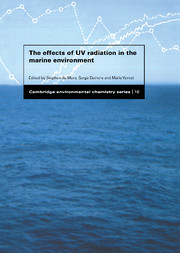Book contents
- Frontmatter
- Contents
- Contributors
- Preface
- 1 Enhanced UV radiation – a new problem for the marine environment
- 2 UV physics and optics
- 3 Spectral weighting functions for quantifying effects of UV radiation in marine ecosystems
- 4 Marine photochemistry and its impact on carbon cycling
- 5 Photochemical production of biological substrates
- 6 Mechanisms of UV damage to aquatic organisms
- 7 Strategies for the minimisation of UV-induced damage
- 8 UV radiation effects on heterotrophic bacterioplankton and viruses in marine ecosystems
- 9 Effects of UV radiation on the physiology and ecology of marine phytoplankton
- 10 Impact of solar UV radiation on zooplankton and fish
- 11 Implications of UV radiation for the food web structure and consequences on the carbon flow
- Index
3 - Spectral weighting functions for quantifying effects of UV radiation in marine ecosystems
Published online by Cambridge University Press: 20 August 2009
- Frontmatter
- Contents
- Contributors
- Preface
- 1 Enhanced UV radiation – a new problem for the marine environment
- 2 UV physics and optics
- 3 Spectral weighting functions for quantifying effects of UV radiation in marine ecosystems
- 4 Marine photochemistry and its impact on carbon cycling
- 5 Photochemical production of biological substrates
- 6 Mechanisms of UV damage to aquatic organisms
- 7 Strategies for the minimisation of UV-induced damage
- 8 UV radiation effects on heterotrophic bacterioplankton and viruses in marine ecosystems
- 9 Effects of UV radiation on the physiology and ecology of marine phytoplankton
- 10 Impact of solar UV radiation on zooplankton and fish
- 11 Implications of UV radiation for the food web structure and consequences on the carbon flow
- Index
Summary
Introduction
Most studies of the effects of UV radiation (radiation with wavelength, λ, < 400 nm) on biological and chemical processes include some component that distinguishes how response varies with wavelength. How fine the spectral distinctions are made depends on the hypothesis to be tested. The simplest hypothesis is whether UV has any effects at all, which is tested using a presence/absence experiment. For example, the effects of treatment exposure to UV and visible radiation (400 < λ < 700 nm) is compared to exposure to visible radiation alone. If there is a difference, then a more complex hypothesis can be tested, e.g. ‘Do effects differ between the three arbitrary divisions of the UV waveband: UV-C (λ = 200–280 nm), UV-B (280–320 nm), and UV-A (320–400 nm)?’ Radiation in the UV-C band is emitted by the sun but does not penetrate the earth's atmosphere. The UV-B band is the shortest wavelength UV in solar irradiance incident to the earth's surface, generally having strong biological effects per unit energy. The energy in the UV-B is small compared to the longer wavelength UV-A band, which has generally weaker negative effects per unit energy. This three-part distinction indicates whether solar UV radiation is capable of inducing effects. Other classifications of UV have been used that even further subdivide each band (Moeller, 1994).
At the other end of the spectrum (so to speak) are investigations that seek the finest resolution possible, i.e. a continuous measure of UV effects as a function of wavelength.
- Type
- Chapter
- Information
- The Effects of UV Radiation in the Marine Environment , pp. 72 - 100Publisher: Cambridge University PressPrint publication year: 2000
- 43
- Cited by



